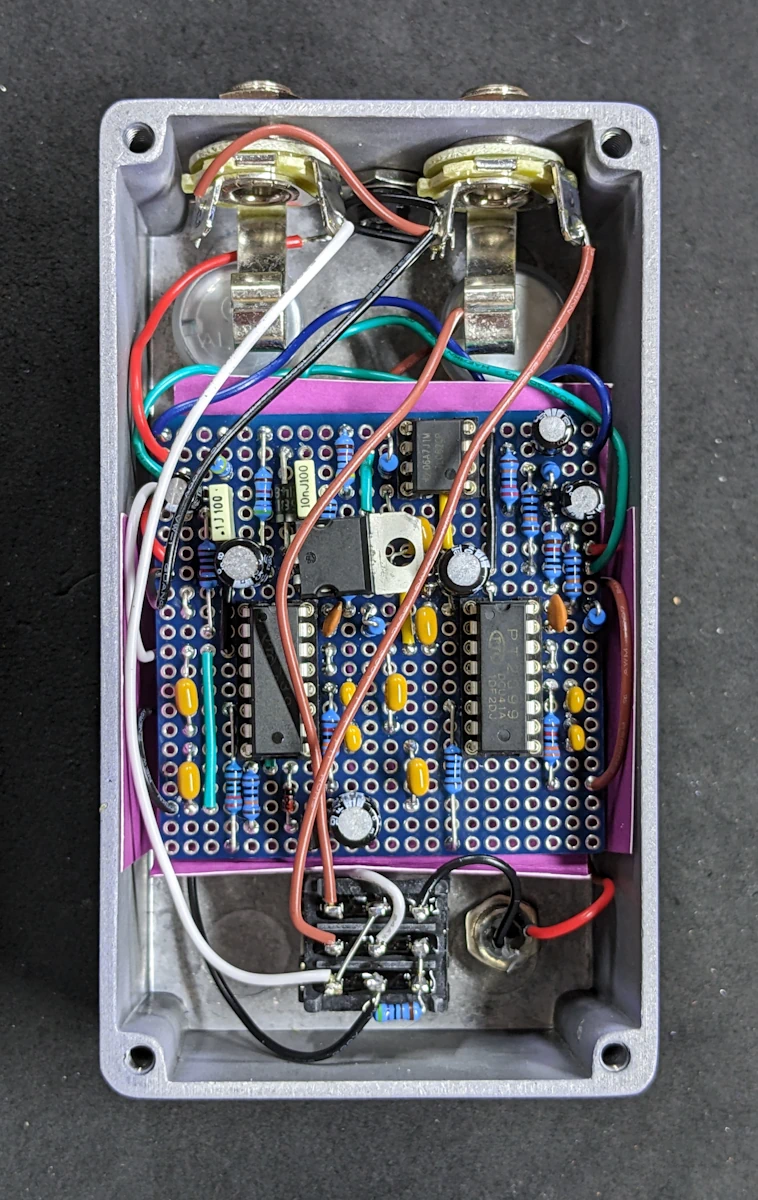

The Halcyon Hot rod
Russian playwright Anton Chekhov was extremely particular about putting rifles on stage, presumably to defend against any errant red herrings that might show up. His opinions on building guitar pedals are not as well-known, but no less apt:
One should not buy a rattle can of French Lilac spray paint unless it’s going to be emptied onto a series of Dimension-style chorus pedals.
Anton Chekhov, Твой тон отстой, 1889
Yes, I have already built several motionless chorus pedals that are more or less (mostly less) in the style of the Boss Dimension-C. It’s one of my favorite sounds, and I keep thinking of ways to potentially improve on my implementations of it.
In my experience, chorus isn’t usually the type of effect that people want to soup up. It’s pretty easygoing and spacey, and doesn’t necessarily invite the lines of questioning that other types of pedals do, like “Is there any way to get a MT-2 Metal Zone, a HM-2 Heavy Metal, and a ML-2 Metal Core in one (metal) enclosure?” or “Will my Rat sound more Rawt if I make a discrete LM308 for it?” or “The next thing under silicon and germanium on the periodic table is tin, so if I put some sweet, sweet Sn transistors in my Fuzz Face, will I achieve tonal Xanadu beyond all blues grimaces?”
The Tranquility Turbo however, is a hot rodded chorus pedal. The performance improvements may not be as self-evident as an Acapulco Platinum with enough additional LM386s to start violating the first law of thermodynamics, but hopefully will allow it to aggressively chill to its fullest potential.
Details
I have previously written about motionless chorus and my attempts to achieve it with PT2399 delay chips, and won’t go into it in great depth here. I first tried it with the Slow Danse Macabre, which is based on a design that’s been floating around on the Internet since 2011 called the Dimension-P. That was intended to be an appetizer while I worked up to building a version based on the Pelota 2 modulated delay—the Pelota 2 is a better delay in a lot of ways, but doubling up the delay lines and making it work as a Dimension-style chorus was on the bleeding edge of my skills. I technically did it, and called it Another Dimension, although I never emotionally connected with that pedal. The Slow Danse always sounded better to me across a wider range of settings, and it’s the one that made it onto my pedal board.
The Slow Danse has its own problems though. For one thing, it’s too quiet. I’m not sure if it’s loss to destructive interference or bad gain management or what, but it’s perpetually below unity, which is a complete drag if you want to turn it on and off in the middle of something without changing volume. The other issue may exist only in my head, and is one of those “feel” things that’s hard to describe, but my sense has always been that it somehow lacks “immediacy.” Like it’s just not all there when you first hit a note. Whether based in fact or not, I attributed it to a poorly-tuned internal mix between the clean signal and the delay lines.
I have been figuring things out lately though, and getting slightly more math-y in my approach to things. I decided that I would redo the Slow Danse Macabre, starting fresh since I’d already modified the original a bunch, and also implementing several changes to address the shortcomings that only became apparent after a lot of use. The result is Tranquility Turbo, including:
- Boosted Gain: I added an op-amp so that I could boost gain at the input to 2.5x. The original was also set to boost, but not this much, and it did it using huge resistors on the individual PT2399s without much attention paid to the the clean signal
- Added Volume Control: I didn’t want to try to perfectly stick the landing on hitting unity gain overall, so rather than adding fixed attenuation at the end to compensate for the input gain, I left it loud and added a knob so that it can be turned down precisely as-needed
- High Voltage: I’m overclocking the PT2399s with 6V of supply voltage, which supposedly allows for shorter delay times. The recommended voltage is 5V (and the “absolute max” is 6.5V) so this may reduce their service life or cause other problems, but I wanted to see if they sounded better hot
- Tweaked Output Mix: I used the other op-amp to add a summing amplifier on the end and thought a lot about how to get the original signal balanced correctly with the two delay lines.
I know for sure that I at least fixed the volume problem. Whether the rest is an improvement is subjective, but it works.
Vital Stats
Sound
It’s not drastically different from previous versions, but is my favorite iteration so far. When first interacting with it, I was concerned that emphasizing the unaffected signal may have made it too tepid of an effect. It’s not really meant to be bludgeoning implement though, and after some messing around, I think it’s just that the sweet spot is in a different part of the range—it may actually be able to go deeper into the “motionless” type of chorus without the LFO swoosh becoming obvious. Of course, it can also be cranked to get that quasi-phaserish swirling type of sound, which is cool, but that wasn’t the main focus of this build.
The following sound sample is the Coronacaster > Tranquility Turbo > Deluxe-ish amp, first completely dry, then with the effect engaged. There’s a second section where the Tranquility Turbo knobs are cranked to intentionally make it swoosh, and there’s a third section where The Wreck of the Ella Fitzgerald is added to hear what it sounds like with distortion.








WAKE UP, KIDS! A NEW DUNNING KRUGER FX PEDAL DROPPED!